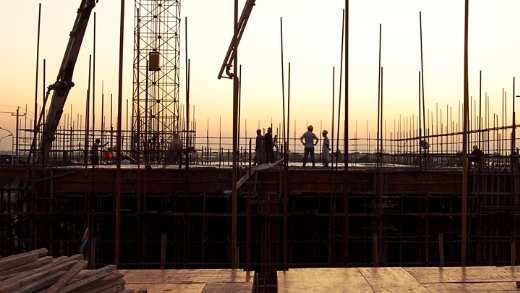How much do ocean circulation patterns impact economic outcomes and sovereign risk? Rick Stathers and Carmen Altenkirch assess El Niño, the climate phenomenon driving atmospheric circulation in the tropics, affecting everything from GDP to inflation and social stability.
Read this article to understand:
- El Niño’s disruptive impacts
- The complex ways El Niño can undermine growth and fuel inflation
- How investors can use that insight to assess sovereign risk in emerging markets
El Niño is back.1 This climate pattern (the warm phase of the El Niño-Southern Oscillation) is marked by warming in the Pacific Ocean, altering the atmosphere in the tropics with big knock-on impacts.
How the trade winds blow, how much rain falls in the Indian monsoon, whether harvests fail in breadbaskets and fishing zones, and how many Californian homes are hit by flooding are just some of the variables that could be affected.
In this Q&A, Rick Stathers (RS), Aviva Investors’ climate pillar lead, and emerging markets sovereign analyst Carmen Altenkirch (CA) take us through the implications and explain how that knowledge is being used to understand sovereign risk.
How many El Niño events have there been in the recent past? What features need to be considered this time around?
RS: El Niño events have been recognised locally for centuries, but it is only since the 1960s that the phenomenon has been acknowledged to have global impacts. Detailed economic analysis is more recent.
The impacts can be direct and short term in some countries and longer term in others, with implications for growth, inflation and social stability. It depends when the ocean warming occurs, and how that impacts atmospheric temperature and rainfall. Some zones get hotter and drier; others get much wetter (see Figure 1).
Figure 1: Typical El Niño rainfall patterns

Note: The regional and seasonal rainfall patterns shown indicate typical but not guaranteed impacts.
Source: Columbia Climate School International Research Institute for Climate and Society, 2023.2
The most recent El Niño events have been in 1972-73, 1982-83, 1997-98 and 2014-16. The financial costs can run into trillions of dollars. For example, the event in 1997-1998 is thought to have cut around $5.7 trillion from GDP over the following five years.3
The impacts could be substantial this time, because there is a lot of energy being stored in the ocean system. Sea surface temperature is already at record highs (see Figure 2), which suggests more energy available to drive extreme events.
Figure 2: Daily average sea surface temperature between 60° North and 60° South, 1979-2023 (°C)
Source: H. Hersbach, et al., 2023.4
The question now is whether the current El Niño develops into a strong event, based on duration and temperature change. That could determine whether 2023 is one of the warmest years on record. It could multiply climate impacts and send average global temperature over a very important international policy marker, 1.5°C above pre-industrial levels.
What happens in the Pacific will have implications for millions of people, directly in their experience of extreme events, and in relation to food security and inflation. Those considerations are highly relevant to insurers and asset managers (see Figure 3).
Figure 3: Southern Oscillation Index and worldwide economic costs connected to extreme weather (US$ billions)
Note: SOI: Southern Oscillation Index gives an indication of the development and intensity of El Niño events in the Pacific Ocean. Values below -7 indicate El Niño events.
Source: Macrobond, July 2023.
How have you been applying what you know to assess prospects in different countries?
RS: Many El Niño impacts are felt by the world’s poorest nations (see Figure 4), and disproportionately among lower income groups and women, but the scale and nature vary. Not all impacts are negative. Argentina has tended to experience higher rainfall, for example, and that might be advantageous for a country mired in drought. It could put an end to the terrible dry conditions that have slashed output of corn and soyabeans.5
India could be negatively impacted by El Niño if the monsoon brings less rain
On the other hand, India could be negatively impacted by El Niño if the monsoon brings less rain. More than half of India’s agricultural land is not irrigated, so we would expect that to result in lower rice output. Research from HSBC in 2014 suggested if rainfall dips by 20 per cent, Indian food inflation could increase by 2.8 per cent and the Consumer Prices Index (CPI) by 1.3 per cent.
An inflationary increase of that size could challenge the government’s ambition to reduce its food subsidy programme for 800 million people, and potentially impact the central bank’s interest rate strategy. If we take this thinking forward, you can understand why sectors and companies with high exposure to rural incomes, including Indian banks and insurers, might also be affected.
The blend of effects is particularly complex in large countries like China, which might experience more rain and floods in parts and drier conditions in others.
Figure 4: GDP impacts in the five-year period following the 1997-1998 El Niño event

Source: Christopher Callahan and Justin Mankin, 2023.6
Is it possible to anticipate the price impacts on different commodities?
RS: It’s difficult given the way local and regional impacts vary. For example, in the past, the impact on the global wheat harvest has tended to be broadly neutral, given the crop is planted globally. The same is true of corn. The three largest corn exporters, the US, Brazil and Argentina, tend to experience neutral to positive impacts from El Niño.
Commodities such as cocoa, coffee, sugar and palm oil tend to experience a more notable price impact
In contrast, commodities such as cocoa, coffee, sugar and palm oil, which have production concentrated in the tropics, tend to experience a more notable price impact. Rice prices, particularly in Asia, also tend to rise.
This time, there are reports of the worst rice deficit for 20 years.7 Severe flooding has hit production in Pakistan – it’s down around one third – while China, the world’s largest producer, has the opposite problem. It’s struggling with drought.
How might this impact inflation?
CA: The potential spill overs could be significant. The European Central Bank recently suggested a one per cent increase in temperature during El Niño could lead to a six per cent increase in food prices over 12 months.8 Bloomberg estimates El Niño could add 3.9 percentage points to non-energy commodity prices and 3.5 per cent to oil prices.9
However, these analyses need to be taken with a pinch of salt. If El Niño coincides with other events, as it did with the Asian financial crisis in the late 90s, it is hard to identify “pure” El Niño impacts.
The food impact is clearly likely to be greater where food makes up a larger share of CPI. In Southeast Asia and parts of Africa, that proportion is high.
Overall, the impact on inflation could be greater than in the last super El Niño
Overall, the impact could be greater than in the last super El Niño. At that point, falling fertiliser prices were driven by lower oil prices, and the fertiliser price is a significant contributor to global food prices. Fertiliser prices have fallen from recent peaks, but unless they fall further, there may be less negative pressure on inflation.
The second factor is the war in Ukraine. Prior to the conflict, the supply of important food commodities was already tight; now it seems the Black Sea Grain Deal with Russia is unlikely to be extended. The deal covered nearly ten per cent of global corn exports, four per cent of global wheat and 12 per cent of sunflower exports.
RS: Most importantly, El Niño is occurring when global temperatures are elevated. Average temperature increases have been particularly rapid over the last twenty years, around twice the global average in some regions.10 There have already been extreme heatwaves in Asia this year, which may amplify the effects of El Niño. If that happens, 2024 could prove even hotter than 2023.
What about impacts outside agriculture?
CA: El Niño can have important second-order impacts on industries like mining. For example, above-average rainfall and flooding could adversely impact copper production in Colombia.
El Niño can have important second-order impacts on industries like mining
On the other hand, much drier weather patterns can be problematic too. Low water levels in the Kariba Dam, a major source of hydroelectric power in Zambia and Zimbabwe, has led to wide-scale power outages, with significant economic and fiscal costs. These, combined with the impact of COVID-19 and economic mismanagement, contributed towards recent sovereign defaults.
This year we are also seeing the impact of drought in Panama, which sees about 3.5 per cent of ocean-going trade via the Panama Canal.11 The canal authority is reporting an unprecedented lack of rainfall, so fewer freight carriers are being allowed through.
What about sector-level impacts?
RS: The two main sectors directly exposed to El Niño are utilities, particularly in South America, and food producers, especially palm oil producers, although there are many others with second-order impacts.
Utilities exposure is highly dependent on geography. Some utilities are already under strain as higher temperatures are increasing electricity demand, resulting in blackouts. For example, there are already severe water deficits in parts of South America. Uruguay is experiencing the worst deficit for over 70 years, and the main reservoir that feeds Montevideo is thought to be at around seven per cent capacity. Uruguay generates around 37 per cent of its energy from hydropower, so this is an important consideration.
El Niño should bring more rain to the southern part of South America and some relief to Uruguay, Chile and Argentina
El Niño should bring more rain to the southern part of South America and some relief to Uruguay, Chile and Argentina. As the northern region of Brazil has been comparatively wet recently, it could have some insulation from the lower levels of rainfall it will receive.
On the food side, we are mindful of the exposure of palm oil producers, given the crop’s limited geographical range. Palm oil is used in many of the packaged products in supermarkets, from processed foods like pizza to lipstick, shampoo and toothpaste. Whether exposure is material at an individual company level depends on the diversification of commodity exposure and extent of vertical integration. We also expect volatility in coffee, cocoa and sugar prices, which may have implications for companies further up the food value chain.
How are you using these insights to assess sovereign risk?
CA: We have been developing our own El Niño vulnerability index. We began with the framework the International Monetary Fund (IMF) put together to assess El Niño country exposure in 2015, including factors like proximity to the equator and country size.12 The closer to the equator and smaller a country is, the greater the impact is likely to be. The IMF included the share of the primary sector (extractive activities, including agriculture and mining) as a percentage of GDP, because countries reliant on those activities are more exposed to the consequences of droughts and floods.
Countries with large dams, reservoirs and irrigation systems will be better placed to ride out periods of drought
While our approach is similar, we have added another element, a country’s capacity to cope, using INFORM Climate Change Risk metrics.13 The rationale is that countries with a higher capacity to cope, for example because they have large dams, reservoirs and irrigation systems, will be better placed to ride out periods of drought. This aspect will become increasingly important in a higher-temperature world.
To assess El Niño impacts on agriculture, we looked at the difference in production in 2015 and 2016, the last major event, against the four preceding years. As well as this imperfect “empirical” assessment of exposure, we make a qualitative assessment of likely impact, based on how the country was impacted in previous El Niño episodes. Our analysis brings all these elements together (see Figure 5).
Figure 5: El Niño vulnerability exposure
Note: Average 2015/2016 from 2011/2014. D = Worse, due to increased drought risk; F = Worse, due to increased flooding; B = better.
Source: Aviva Investors. Data as of June 30, 2023.
We see El Niño as a potential headwind to disinflation and growth. It is too early to assess the exact magnitude, but we are paying extra attention to countries that might be left worse off, particularly those with weak economic fundamentals to begin with. In countries with a high degree of agricultural dependency, El Niño could result in less revenue for governments, weighing on sentiment and limiting the upside on bond prices.
We see El Niño as a potential headwind to disinflation and growth
Countries like South Africa, which suffers from droughts during El Niño years, could see inflation elevated and limit the extent to which the Reserve Bank can cut rates. The same could well be true in parts of Latin America. Peru, for example, has a dependency on hydroelectricity, which could aggravate the food shock through higher energy prices.
El Niño is also relevant for Ghana and Zambia. We had become more constructive on those countries recently, as we expect them to complete their debt restructurings over the coming months. That view is tempered by our understanding of potential negative El Niño impacts.
The flip side is that some countries like Argentina might see improved harvests, which would help alleviate foreign exchange shortages. That could provide an investment opportunity.
The impacts of climate change are growing with every fractional increase in average temperature
RS: The world is entering uncharted climate territory. There will be spill overs, and we need to invest in adaptation solutions to a warmer climate urgently. With the impacts of climate change growing with every fractional increase in average temperature, we must focus on what needs to change if society is to cushion itself from the worst of it.
The United Nations Environment Programme's 2022 Adaptation Gap Report suggests adaptation finance for developing countries is around five to ten times lower than what’s required, and the shortfall is widening.14 There’s a lot to do.


















